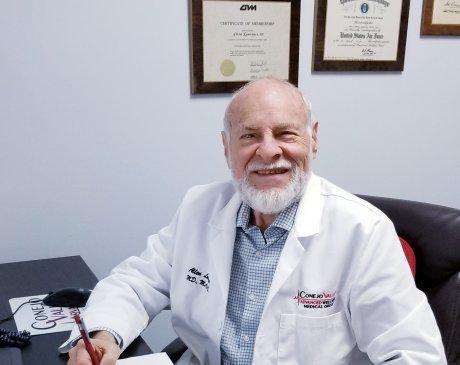- 21103 Vanowen St Woodland Hills, CA 91303 | Call us today!
- 310-879-9266
Hormone Replacement Therapy (HRT) for Menopause

Menopause is a natural part of life that any woman who lives long enough will experience. It typically occurs in two stages—there’s the Peri-Menopause Stage, which usually begins around age 35-40 and lasts until the woman’s menstrual period stops for at least one full year. The second part is generally referred to as the Post-Menopause Stage ages 45-90, and it begins one year after the woman’s last or final menstrual period and last through the rest of her life.
Many women continue to menstruate throughout peri-menopause period, so for simplicity’s sake, most of the time we say menopause starts after a year of no menstrual periods. But these two periods when combined are the menopause and make up the entire menopausal period. Commonly, most women start their menopausal journey between the ages of 35 and 55. While many women stop menstruating in their mid to late 40’s, there are also many women who continue to have menstrual periods until even after the age of 55. Statistically, the women who stop menstruating later tend to have a slightly greater risk of breast cancer hence, should have routine mammography and perform regular self-breast exams and be ever vigilant.
Contrary to years of misleading news reports, Hormone Replacement Therapy, HRT, especially bioidentical HRT (BHRT) is an excellent way of protecting yourself and helping your body better manage the menopausal symptoms experienced during both the peri- and post-menopause.
If you worry about breast cancer or have a family history of breast cancer then regular medical HRT, specifically synthetic, non-bio-identical hormone replacement therapy (Premarin and Provera), should be avoided, as they can definitely increase most women’s chance and risk of getting breast cancer. Regular medical non-bio-identical hormone replacement therapy, commonly given out by most Gynecologist, should not be considered without an in-depth understanding of how your body will interact with synthetic hormones. The risk of breast cancer is lower when using bio-identical female hormones, as are the risks of heart attach and stoke, bowel cancer and most other problems we now recognize are associated with synthetic hormone replacement.
Types of HRT (Synthetic vs Bio-Identical HRT)
As I have said above, there are two main types of hormone replacement therapies: 1) Synthetic (typically using horse (equine) urine estrogen) and a synthetic progestogen, and 2) Bio-Identical female hormone replacement therapy, that is, using, female hormones which are exactly biologically identical (that is, have the exact the same structure) as the estrogen (Estradiol) and progesterone previously made by your own body, since even before she you started menstruating. About half of all women who use synthetic HRT end up having to stop using hormone replacement therapy after about a year or two, because they are unable to tolerate the many negative side effects and complications that they experience. Synthetic hormones, when given alone (synthetic estrogen, without progesterone) are also problematic because of their tendency to produce unbalanced hormonal response, which can ultimately lead to not just feeling off, but also increased risk of breast cancer, increased risk of heart attacks and strokes, increased possibility of bowel cancer and the many other lessor, but frequently uncomfortable medical problems associated with synthetic hormones.
These risks and problems, rarely talked about in the press are why most women tend to go for bioidentical hormone replacement therapy verses synthetic hormones. Since many Western trained gynecologists are only trained in using synthetic hormone Replacement, bio-identical hormones are not always easily available. Another confusing problem is that most insurance companies chose not to pay for bio-identical hormones and instead opt to only pay or reimburse when women use synthetic replacement hormones. A conundrum considering that these same synthetic hormones cause many of the costly problem they tell everyone they really would love to prevent. Also, because they cause many times more of a health problem then bio-identical hormones, much more dangerous and ultimately, because of this, more costly.
The benefits of Bio-Identical HRT
Most women who decide they will take advantage of bio-identical hormone replacement therapy to treat their menopausal symptoms often do so for two main reasons:
- Bio-Identical HRT reduces or eliminates negative side effects and symptoms and discomfort caused by menopause, and
- Bio-Identical HRT reduce the negative biologic or physiologic effects of menopause, such as aging, increased risk of heart attack and stroke, which are often dangerous and even lethal.
There are however, some drawbacks associated with BHRT, which prospective patient must consider. They may cost more. They are a bit harder to get and you have to care enough about yourself and your body to even have read this article. Your insurance may not pay for the medication. Ahh!, but they still have to pay for the evaluation, your exam and for routine testing.
Yes, you still will need to have your regular medical follow up, we also suggest regular annual pap smears and mammography. I tell every woman that this should never be seen as a pro lem, rather it should be seen as a benefit that every woman should take advantage of, as it will allows them to act aggressively in protecting themselves from risks they have do to being a woman and as they age.
Any woman who is interested in potentially undergoing bio-identical HRT at the onset of peri-menopause or during their post-menopausal years, should first consult with a medical doctor who is trained and experienced with using, prescribing and following women who use bio-identical hormones. Most gynecologist, GP’s and family practitioners are not trained in using bio-identical HRT and do not understand either how to explain bio-identical , nor their use, or their benefits. Bio-identical HRT is still HRT and it is always essential to be sure that if there are any risks, these risk are prevented, and if they worst happens, that the women are adequately treated.
It is essential that prevention is always an important part of your medical care. Using bio-identical HRT clearly outweigh using synthetic HRT. Your risks of all problems, are lower with BHRT and your benefits are always greater with BHRT. Since every woman’s body is different, you must always be treated as an individual and your bio-identical (or synthetic HRT, if you chose to still do that) use, must always be tailor made for your body and your needs. This can only be done by consulting with an expert who regularly treats menopause using BHRT. Only after consulting with a well-trained professional will you be able to make the very best informed decision, the decision that will be best and most right decision for you.
For more information about either Male or Female Hormone Replacement Therapy, Call 310-879-9266 for answers or for an appointment.

Article by Dr. Allen Lawrence, M.A., M.D., Ph.D.




